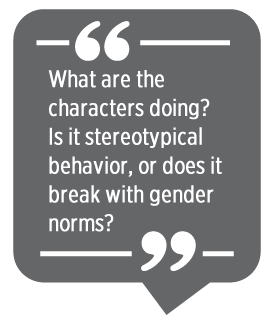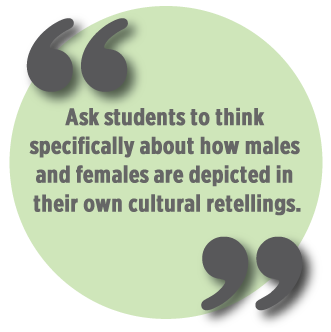Gender Bias in Classroom Texts: Strategies to Challenge It
by Amy Burden

We all want to treat our students equitably, no matter where they are from or how they identify. We choose texts, songs, activities, and movies that we believe represent all our students positively. We try to call on students equally and encourage all students to share their thoughts and ideas with the class. But, with all we do as English language teaching (ELT) professionals to create a safe and equitable learning environment, ELT materials often still contain subtle forms of gender bias that can have a negative effect on our students.
This article provides you with strategies for analyzing your teaching materials for subtle forms of bias and ideas on how to respond to that bias to build critical awareness through communicative activities that foster language learning at all levels of ELT.
Tips for Identifying Bias in Your ELT Reading Materials
1. Begin With Counting
There is a simple way to quickly analyze your reading materials for bias. You can count gendered nouns and gendered pronouns over several reading selections. Does one unit have a higher quantity of male or female grammar structures? Do the reading selections balance one another out? (I.e., one reading may have higher occurrences of males, while the next, females, and the following contains equal representation or gender neutrality.)
Count verbs and adjectives that surround those gendered nouns and pronouns. Do they positively depict those males and females? Is there variety in what these gendered nouns do, think, or feel? Who gets richer descriptions or is more active in these readings?
Get your students involved in this process and make it a prereading activity. Students can circle gendered pronouns and nouns and predict who or what the story will be about. While they read, they should highlight verbs or adjectives and discuss how each character is described. Ask comprehension questions about concrete actions within the reading. This is a great way to connect concepts of grammar to their use in authentic contexts. This works with all levels and ages of ESL. For more complex texts, you can assign short sections for analysis, or divide students into groups for jigsaw style analysis.
 2. Look at Pictures
2. Look at Pictures
A second simple way to analyze your reading materials for bias is to examine drawings and photographs that accompany them. There are several things to look for when doing this. First, it’s a good idea to count again. Are there more drawings of males, females, or neutral characters within a unit or extended reading? Then, consider whether characters are drawn to display their gender, such as with clothing, coloring, or body language. Is it necessary to have the gender of the character drawn in that reading? Next, consider the types of activities characters are doing in the images. This is a good time to notice who is passive as well. What are the characters doing? Is it stereotypical behavior, or does it break with gender norms?
Other ways to examine pictures is to look at positioning on the page. Who is foregrounded and who is backgrounded; who is drawn larger or taller; and who is smaller, seated, kneeling, or lying down? Finally, who is looking at whom? Are they looking up or down at someone or something? These characteristics of images give or take away status. Larger, taller characters who look down at those around them carry more status. Characters who are small or who are drawn behind someone or something else have their status taken away.
Again, get your students involved in this process. Students can examine the images in this way to gather clues about the readings. While they read, students can look ahead at images and make predictions about what happens next and to whom. As a postreading activity, students can compare the images to what they read to see how they fit or in what ways they are incongruent with the reading. Students can use adjectives of size, shape, color, and emotion to describe the images they’ve analyzed and compare this to reality.
Teaching English Critically With Gender-Biased Materials
When you do find that an extended reading or a unit (or even an entire textbook!) contains subtle forms of bias or sexism, there are several ways you can still use these materials in a positive manner. Following are examples that work with all ages and levels of ESL/EFL to promote critical awareness.
1. Story Comparisons
Divide students into small groups. Give each group an alternate telling of a fairytale, folktale, biography, or nonfiction story studied in class. There are many child-friendly retellings of fairytales and folktales from different perspectives. Charnae Gordon compiled a list of multicultural retellings that would be excellent for the English language classroom. You may find that biographies or nonfiction pieces in your text diminish or exclude the work of women, so look for nonfiction texts and biographies that more accurately portray the female contribution. Colours of Us has an extensive list of these that would work well for English learners.
Students should create Venn diagrams on the male and female protagonists in each version. Each group can present their diagrams, and a vote can be cast on which character the class prefers. Have a short discussion on why the class voted as they did, guiding students to appreciate males, females, and neutral characters who respond in less stereotypical ways to problems that arise in the stories.
2. Engage With Student Voices
After students analyze a text such as a fairy tale, biography, nonfiction piece, or folktale, ask them to share a similar story, person of interest, or event from their own culture. This can be done as a think-pair-share or drawing activity in lower levels, or as a composition or presentation activity with more advanced learners. Ask students to think specifically about how males and females are depicted in their own cultural retellings. Whose perspectives, thoughts, and feelings are given in that version? Whose perspectives are missing? How does this differ from the one you read in class?

3. Redesign
After completing a reading or unit, invite students to write, draw, or act out alternate endings that value a different character’s point of view. Students can even get crafty, creating objects, music, movement, paintings, or videos that promote a perspective from their home culture on a given theme, reading, or genre.
This is a wonderful opportunity for collaborative group redesign. Encourage students to get to know their classmates’ strengths, weaknesses, and desires when it comes to creating a multimodal redesign and divide up the tasks along those recommendations, allowing every student the opportunity to uniquely express their talents and points of view while redesigning a more egalitarian story for the class.
Examining Other Kinds of Bias
Though this article has only discussed gender bias, we all know that other forms of bias exist within our texts, classrooms, schools, and communities. Other forms of bias can also be located and challenged in the ways presented in this article. Here are a few ways to engage your students in further analysis of bias in what they read:
-
Students can look for characters that look or dress like them in images and create new characters through multimodal writing.
-
Ask students to compare the gendering of English to how their home language uses grammar to address gender, age, and other cultural features. Look for nouns, verbs, and adjectives in multicultural retellings not just regarding gender but also religion, ethnicity, and age, making comparisons to the class text.
-
Consider the variety of English used in each story. Whose perspective would be included if it were told in a different dialect, nonstandard form, or in a different language?
It’s very possible to both identify and still use learning materials that contain bias. This can be a great opportunity for seizing critical moments to foster inclusivity and critical engagement during language learning through comparison, design, and redesign with diverse perspectives.
Amy Burden is currently teaching in the first-year writing program at The University of Memphis while finishing her PhD in applied linguistics. She taught English for academic purposes for 8 years and has worked extensively in both pre- and in-service teacher training. She has published on a variety of subjects in the ELT field, from peer review to technology teaching tools. She has led training workshops and presented at conferences locally and abroad.